|
HISTORIC FDNY FIREBOATS
"Pre 1900"
The following special photos were submitted as
listed below.
(Added August 2013 - Updated September 2015)
______________________________
GO TO NEXT PAGE 13
For fireboats 1900 - 1950
______________________________
GO TO NEXT PAGE 14
For fireboats 1951 - 2000
______________________________

Steam side Paddle wheeler "Seneca" in 1864 - John Landers - Beth Klein Collection
"Seneca"
(NYPD c. 1862-1881 )
This side paddle wheel vessel was obtained by the New York Police
Department.
It was at one time used by NYPD to lure and arrest "Pirates" on the
Hudson.
On occasion she was used by the Brooklyn Fire Dept for fire
fighting.
The Seneca was reported to have been destroyed by fire in 1881.
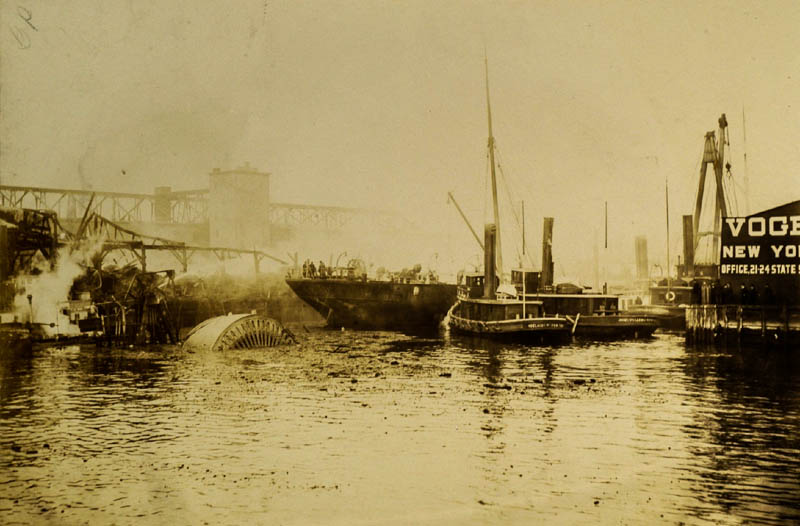
Steam Tug "John Fuller" operating at a fire John Landers - Beth Klein Collection
"John Fuller"
(On Call c. 1866-1875)
Perhaps the "first" firefighting boat in NYC.
A steam salvage tug equipped with Amoskeag fire pumps
Owned by John C. Baxter & Son
Rented as needed "On Call" basis.
Known as a "wrecking & fire steamer"
13 water streams
It served for 9 years 1866-1875
and then for years was rented to substitute for
fireboats Havemeyer and Mills when they were out of service.
Berthed at 307 West Street, Manhattan
BELIEVED TO BE THE ONLY PHOTOS IN EXISTENCE OF THE FULLER
She is the tug on the right, right of center, next to sister tug the
"Adelaide"
Shown fighting a fire in what appears to be a steam paddlewheel vessel and pier
fire.
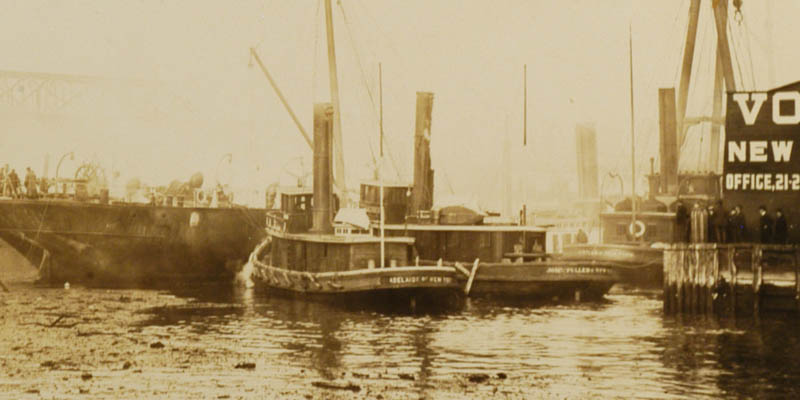
Close-up of Steam Tug "John Fuller" operating at a fire John Landers - Beth Klein Collection
"John Fuller"
(Rental c. 1866-1875)
Perhaps the "first" firefighting boat in NYC.
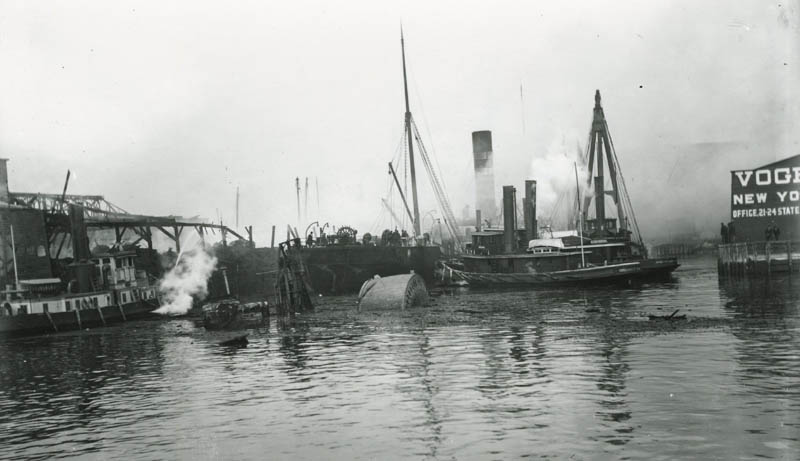
Steam Tug "John Fuller" operating at a fire John Landers - Beth Klein Collection
"John Fuller"
(Rental c. 1866-1875)
Perhaps the "first" firefighting boat in NYC.
A salvage tug equipped with Amoskeag fire pumps
Rented as needed "On Call" basis.
Berthed at 307 West Street
BELIEVED TO BE THE ONLY PHOTOS IN EXISTENCE OF THE FULLER
She is the tug on the right, right of center, next to sister tug the
"Adelaide"
Shown fighting a fire in what appears to be a steam paddlewheel vessel and pier
fire.

Close-up of Steam Tug "John Fuller" operating John Landers - Beth Klein Collection
"John Fuller"
(Rental c. 1866-1875)
Perhaps the "first" firefighting boat in NYC.
A salvage tug equipped with Amoskeag fire pumps
Rented as needed "On Call" basis.
Berthed at 307 West Street
BELIEVED TO BE THE ONLY PHOTOS IN EXISTENCE OF THE FULLER
She is the tug on the right, right of center, next to sister tug the
"Adelaide"
Shown fighting a fire in what appears to be a steam paddlewheel vessel and pier
fire.
|
A Powerful Fire
Extinguisher - Exhibition Trip of the Fire Steamer John
Fuller
The steam-tug John
Fuller, belonging to Messrs J. C. Baxter & Sons,
went out yesterday for the purpose of giving an
exhibition of the power f her steam-pumps, used in the
extinguishment of fires that occur along the waterfront
either of this City of of Brooklyn. The Fuller
has been connected with the Fire Department of New York
and Brooklyn since the organization of the paid
departments, and has done remarkably good service when
her aid has been called in.
The trip yesterday
was given at the request of the new appointees of the
New York Department, who knew nothing as to her capacity
and usefulness as a fire extinguisher. There were
present on this trip, also, a number of the members of
the Boards of Marine and Fire Underwriters, members of
the press, the principal officers of the Fire
Departments of New York and Brooklyn, and other invited
guests.
After leaving the
foot of Charlton Street, North River, at 10. and the
foot of Wall Street, East River, at 10-1/2 A.M., the
Fuller steamed down to City Island, where he gave an
exhibition of her powers, playing eight powerful streams
of water at one and the same time, a quantity
sufficient, apparently, to deluge any conflagration
against which they might be directed. The water is, of
course, drawn up from the river.
The Fuller is
a large sized tug, built in Philadelphia as a wrecking
and fire steamer, has steam cylinders twenty-three
inches square, and is capable of throwing 8,000 gallons
of water per minute. The eight streams can be turned in
any direction, or can all be concentrated, if necessary,
against any one point. During the drouth which afflicted
Philadelphia, last year, she threw a column of water
from the river, one foot in diameter and 110 feet high,
into the Fairmount reservoir for eighteen days and
nights, uninterruptedly. Her performances, yesterday,
gave ample satisfaction to the crowd who were invited to
witness them and all were lavish in their praises of her
extraordinary capacity.
She lies every night
as the foot of Charlton Street, with fires "up," in
readiness to proceed wherever her services are needed.
The excursionist returned about 6 o'clock P.M. |
From a
clipping from New York Times July 23, 1870
Describing the actions of the first vessel providing firefighting
capabilities
in the City of New York and Brooklyn.
Provided by John Landers
"John Fuller"
(Rental c. 1866-1875)
Perhaps the "first" firefighting boat in NYC.
A salvage tug equipped with Amoskeag fire pumps
Rented as needed "On Call" basis.
Berthed at 307 West Street
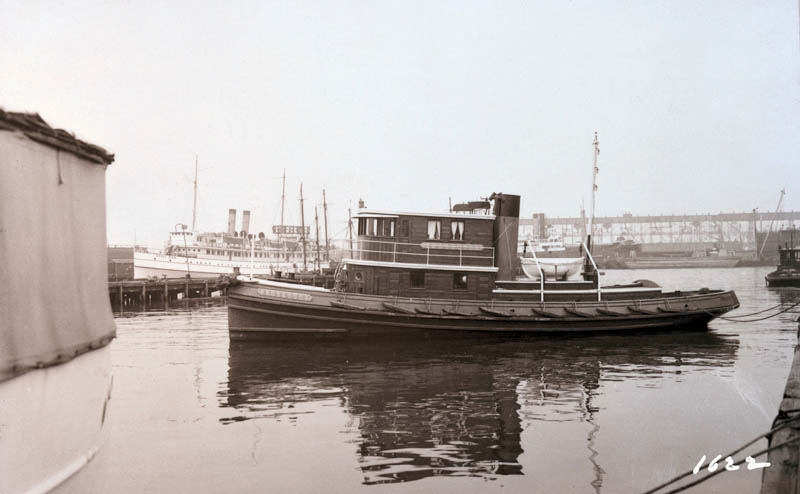
Steam Tug "Protector" used in Brooklyn John Landers - Beth Klein Collection
"Protector"
(On Call c. 1894- ? )
A 53 foot steam tug own and operated by Newtown Creek Towing Co,
in Long Island City (now part of Queens) on the East River
was utilized from time to time for firefighting.
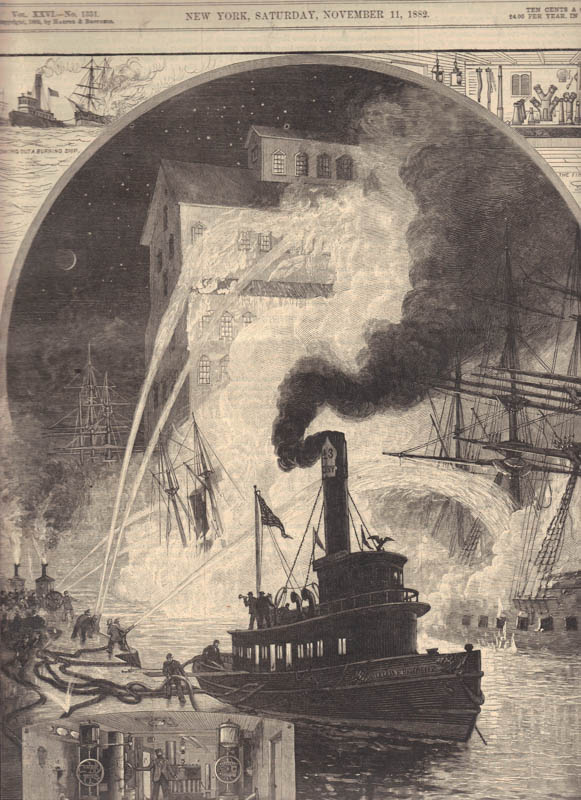
Drawing of the
"William F. Havemeyer" John Landers - Beth Klein Collection
Image from Nov 11, 1882 cover of Harper's Weekly
"William F. Havemeyer"
(1875-1901)
106' x 22' x 10'. 6000 gpm.

Fireboat
"William F. Havemeyer" John Landers - Beth Klein Collection
"William F. Havemeyer"
(1875-1901)
106' x 22' x 10'. 6000 gpm.

Fireboat
"William F. Havemeyer" John Landers - Beth Klein Collection
"William F. Havemeyer"
(1875-1901)
106' x 22' x 10'. 6000 gpm.
The "first" fireboat of the City of New York
Wood hull - coal fired steam powered
Had quarters on boat for the crew
Pike Street, Manhattan, East River
"Engine 43"

Fireboat
"William F. Havemeyer" John Landers - Beth Klein Collection
"William F. Havemeyer"
(1875-1901)
106' x 22' x 10'. 6000 gpm.
The "first" fireboat of the City of New York
Wood hull - coal fired steam powered
Had quarters on boat for the crew
Pike Street, Manhattan, East River
"Engine 43"

Fireboat
"William F. Havemeyer" John Landers - Beth Klein Collection
"William F. Havemeyer"
(1875-1901)
106' x 22' x 10'. 6000 gpm.
The "first" fireboat of the City of New York
Wood hull - coal fired steam powered
Had quarters on boat for the crew
Pike Street, Manhattan, East River
"Engine 43"

Fireboat
"William F. Havemeyer" John Landers - Beth Klein Collection
"William F. Havemeyer"
(1875-1901)
106' x 22' x 10'. 6000 gpm.
The "first" fireboat of the City of New York
Wood hull - coal fired steam powered
Had quarters on boat for the crew
Pike Street, Manhattan, East River
"Engine 43"
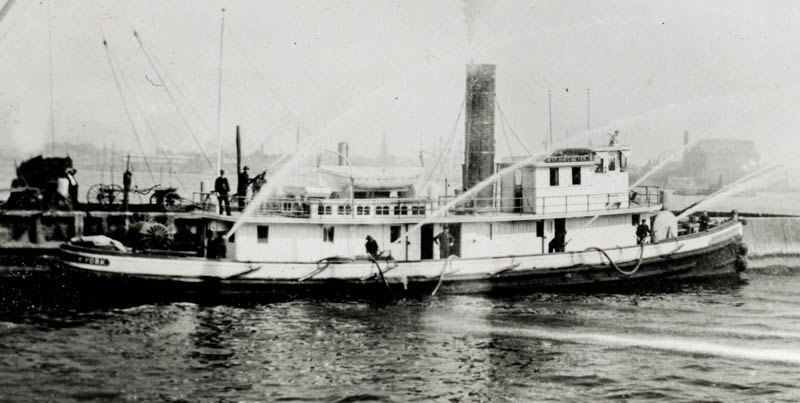
Close-up of
Fireboat
"William F. Havemeyer" John Landers - Beth Klein Collection
"William F. Havemeyer"
(1875-1901)
106' x 22' x 10'. 6000 gpm.
The "first" fireboat of the City of New York
Wood hull - coal fired steam powered
Had quarters on boat for the crew
Pike Street, Manhattan, East River
"Engine 43"
| Transcript of a Nov 11, 1882
Harper's Weekly Story. THE FIRE-BOAT OF NEW
YORK HARBOR
Not least important in the Fire Department of New York city is the
harbor fire-boat William F. Havemeyer, or, as she
is officially known, Engine No. 43, N.Y.F.D. This
fire-boat is a powerful steam-tug of 110 tons burden,
and was built in 1875 by Wood & Dialogue, of Camden, New
Jersey, by order of Fire Commissioners Perley, Van Cott,
and Hatch. She is propelled by a low-pressure engine of
300 horse-power, and is one of the swiftest tugs in the
harbor. She has made the distance from her berth - Pier
1, North River, close beside Castle Garden-to the foot
of West Twelfth Street in twelve minutes.
For fire apparatus the Havemeyer is provided with two
powerful Amoskeag pumps, capable of throwing 2000
gallons of water per minute. This immense volume of
water can be thrown through ten separate lines of hose,
or connected in one, from which it discharges with force
sufficient to overthrow brick walls or tear down a
substantial building.
An amusing incident in the career of the fire-boat happened a
few years ago, upon her return from a short excursion
down the bay, with a party of Western chief engineers of
fire departments on board. An elevator in Brooklyn was
on fire, and several tub-boats were throwing streams of
water upon it. As the Havemeyer approached, with
a view of rendering assistance, and at the same time
showing the Western visitors of what she was capable,
the tugs directed the several streams against her for
the purpose of driving her off. Instead, however, of
leaving she turned two of her powerful streams upon
them, and within five minutes had the field to herself
having completely deluged her opponents. She then went
to work and subdued the fire, to the great admiration of
her guests.
Her equipment includes nearly 5000 feet of the best rubber
hose of which is three inches in diameter, the largest
ever made, and a large assortment of nozzles, among
which is a "Siamese," or double nozzle, and a "double
Siamese," or quadruple nozzle. She is connected with the
regular fire alarm of the city by a cable, which can be
detached at an instant's notice, and with the several
engine-houses by telephone. Her fires are never
allowed to go out, and a constant head of fifty pounds
of steam is maintained in her boilers. She is always
clear of her berth within a minute after receiving an
alarm, ad has been cleared and got under way in thirty
seconds.
The crew of fourteen men is commanded by Captain R.R.
Farrell, who ranks with the foreman of a land company,
and Lieutenant W.C. Braisted, who ranks as assistant
foreman. There are also two pilots, two engineers, three
stokers, and five men who act as deck hands, or, at a
fire, as firemen. The duty is arduous, for all hands
must sleep on board, and though they may take their
meals at their homes, no more than two men are allowed
to leave the boat at a time, and at fires the work is
incessant and more prolonged than that of land
companies. The reasons of this prolonged duty is that
the Havemeyer uses salt-water, she is employed to
drench out fires that come within her reach, in order
that Croton may not be wasted. Thus, during the holiday
season last winter, she was stationed for ten days
opposite the United States Storage Warehouse fire on
South Street, during all of which time she kept a steady
stream playing upon the smouldering ruins.
The fire-boat is expected to answer all calls along the
water-front of either river within the city limits, and
upon her arrival at the scene of a fire her Captain
reports to the Chief of Battalion in charge, and
receives orders from him the same as a foreman of a land
company. In addition to this duty, the fire-boat must be
ready at all times to go to the assistance of any
vessels getting on fire in the harbor, and, if
necessary, must tow all vessels in dangerous proximity
to the burning one to a place of safety, or tow away the
burning vessel itself. On special occasions she has
responded to calls beyond the city limits, once going as
far as Tarrytown, and once, when Hoboken firemen were on
a strike, rendering valuable assistance in subduing a
fire that broke out on the Eagle-Steamship Company's
pier, and saving much property.
It is estimated that the Havemeyer has saved
from destruction property worth more than her weight in
gold, and realizing her importance, and also her
inability to all calls made upon her along our
constantly increasing line of water-front, the Fire
Commissioners have ordered another fire-boat to be
built. This new boat, now in the process of
construction, will be considerably larger than the
Havemeyer.
The crew of the present fire-boat are an active,
well-trained lot of men, who take great pride in their
craft, and spend their spare time in burnishing her
brass fittings, painting her wood-work, or in otherwise
beautifying her. They have also on occasions exhibited
great personal bravery, not only at fires, but while
lying quietly at Pier 1. There is not one of them who is
not ready to spring overboard in answer to a cry of
distress, and several persons who have fallen or been
thrown into the water in this vicinity owe their lives
to the brave crew of the fire-boat Havemeyer.
|
Transcript of 1882 Harper's Weekly story John Landers - Beth Klein Collection
"William F. Havemeyer"
(1875-1901)
106' x 22' x 10'. 6000 gpm.
The "first" fireboat of the City of New York
Wood hull - coal fired steam powered
Had quarters on boat for the crew
Pike Street, Manhattan, East River
"Engine 43"

The fireboat
"Zophar Mills" prior to delivery John Landers - Beth Klein Collection
"Zophar Mills"
(1882-1934)
120' x 25' x 12'. 6000 gpm.
The original Zophar Mills at Prusey and Jones Ship Building Company
in Wilmington, Delaware
prior to delivery.
Note: The Zophar Mills was named after a New York volunteer
who did not miss a fire in 45 years of service.

1883
Drawing of the
"Zophar Mills"
John Landers - Beth Klein Collection
"Zophar Mills"
(1882-1934)
120' x 25' x 12'. 6000 gpm.
First berth at Pier 42, North River
First with iron hull
Twin Clapp and Jones 3000 gpm pumps
Accommodations for 19 crew members.
Served 52 years
"Engine 51"
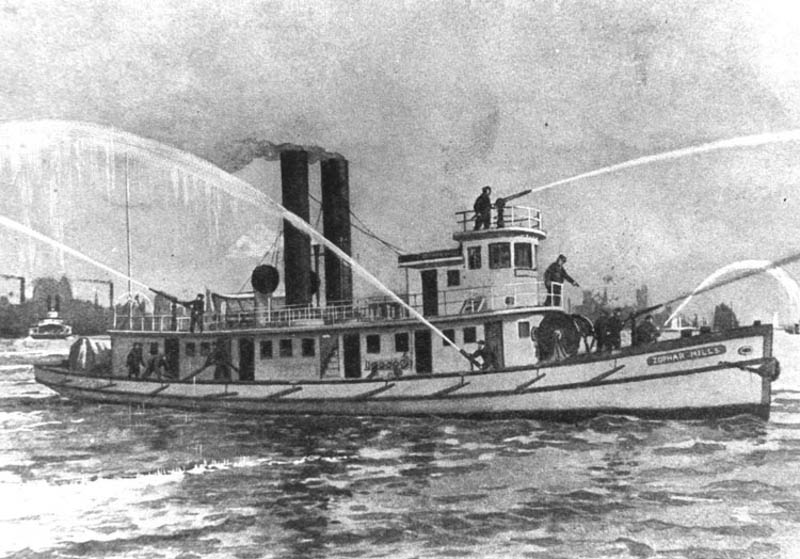
Drawing of the
"Zophar Mills" John Landers - Beth Klein Collection
"Zophar Mills"
(1882-1934)
120' x 25' x 12'. 6000 gpm.
First berth at Pier 42, North River
First with iron hull
Twin Clapp and Jones 3000 gpm pumps
Accommodations for 19 crew members.
Served 52 years
"Engine 51"

Photo of the
"Zophar Mills" John Landers - Beth Klein Collection
"Zophar Mills"
(1882-1934)
120' x 25' x 12'. 6000 gpm.
First berth at Pier 42, North River
First with iron hull
"Engine 51"

Photo (closeup) of the
"Zophar Mills" John Landers - Beth Klein Collection
"Zophar Mills"
(1882-1934)
120' x 25' x 12'. 6000 gpm.
First berth at Pier 42, North River
First with iron hull
"Engine 51"

Fireboat
"Zophar Mills" at the General Slocum fire June 15,
1904 - John Landers - Beth Klein Collection
"Zophar Mills"
(1882-1934)
120' x 25' x 12'. 6000 gpm.
First berth at Pier 42, North River
First with iron hull
"Engine 51"

Fireboat
"Zophar Mills" at the General Slocum fire June 15,
1904 - John Landers - Beth Klein Collection
"Zophar Mills"
(1882-1934)
120' x 25' x 12'. 6000 gpm.
First berth at Pier 42, North River
First with iron hull
"Engine 51"
*******************************
THE GENERAL SLOCUM FIRE
The General Slocum was an excursion steamer. On June 15, 1904, the
Slocum had over 1,400
people on board, including a large number of children on a Sunday school outing.
Fire was reported
about 10:11 A.M. when the vessel was at Hells Gate near Hallets Point. Box 2339
was transmitted.
The fireboat Abram S. Hewitt was dispatched. The fire burned rapidly and 1,021
deaths
were reported. Only about 400 were rescued. The Slocum sank near North Brothers
Island.
It continues to be one of the worst marine disasters.
*******************************

Fireboat
"Zophar Mills" at the General Slocum fire June 15, 1904
John Landers - Beth Klein Collection
"Zophar Mills"
(1882-1934)
120' x 25' x 12'. 6000 gpm.
First berth at Pier 42, North River
First with iron hull
"Engine 51"

Fireboats
"Zophar Mills" and "Abram S Hewitt" and "Velox"
at 1909 pier fire
John Landers - Beth Klein Collection
"Zophar Mills"
(1882-1934)
120' x 25' x 12'. 6000 gpm
First berth at Pier 42, North River
First with iron hull
"Engine 51"

Fireboats
"Zophar Mills" "Abram S Hewitt" and "The
New Yorker" at 1909 pier fire
John Landers - Beth Klein Collection
"Zophar Mills"
(1882-1934)
120' x 25' x 12'. 6000 gpm
First berth at Pier 42, North River
First with iron hull
"Engine 51"

Fireboats
"Zophar Mills" "Abram S Hewitt" and "The
New Yorker" at 1909 pier fire
John Landers - Beth Klein Collection
"Zophar Mills"
(1882-1934)
120' x 25' x 12'. 6000 gpm
First berth at Pier 42, North River
First with iron hull
"Engine 51"

Fireboat
"Zophar Mills" and "William Gaynor" at 1915 Pier Fire -
John Landers - Beth Klein Collection
Note original image from a glass negative (note the crack).
"Zophar Mills"
(1882-1934)
120' x 25' x 12'. 6000 gpm.
First berth at Pier 42, North River
First with iron hull
"Engine 51"

Fireboat
"Zophar Mills" and "William Gaynor" at 1915 Pier Fire -
John Landers - Beth Klein Collection
Note similar photo as above from non-cracked glass negative
"Zophar Mills"
(1882-1934)
120' x 25' x 12'. 6000 gpm.
First berth at Pier 42, North River
First with iron hull
"Engine 51"

Fireboat
"Zophar Mills" on right with celebratory water display in honor
of the fleet's newest boat - The "John J. Harvey" Oct 6, 1931.
John Landers - Beth Klein Collection
"Zophar Mills"
(1882-1934)
120' x 25' x 12'. 6000 gpm.
First berth at Pier 42, North River
First with iron hull
"Engine 51"

Fireboat
"Zophar Mills" at Engine 51 Quarters Pier 42 North
River
John Landers - Beth Klein Collection
"Zophar Mills"
(1882-1934)
120' x 25' x 12'. 6000 gpm.
First berth at Pier 42, North River
First with iron hull
"Engine 51"

Fireboat
"Zophar Mills" has reached the end of her FDNY days
and awaits dismantling.
Gone is the pilot house name board as well as the roof top, bow and stern
monitors. c.1934
John Landers - Beth Klein Collection
"Zophar Mills"
(1882-1934)
120' x 25' x 12'. 6000 gpm.
First berth at Pier 42, North River
First with iron hull
"Engine 51"
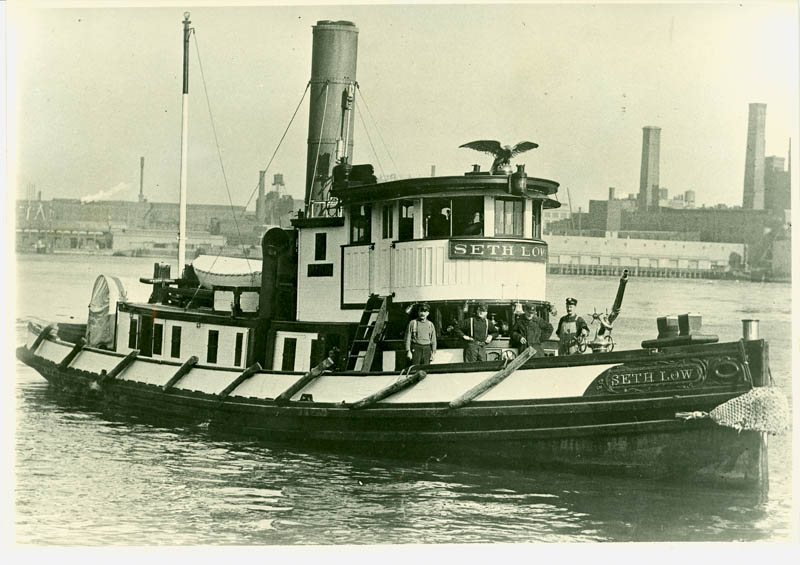
Fireboat
"Seth Low" on the East River John Landers - Beth Klein Collection
"Seth Low"
(1885-1917)
99' x 24' x 9'. 3500 gpm.
Harbeck's Stores, foot of Main Street, Brooklyn
Built by W. Cowles of Brooklyn.
Wooden vessel - copper bottom
Twin Clapp & Jones 3500 gpm pumps
Brooklyn Fire Dept
Engine 23
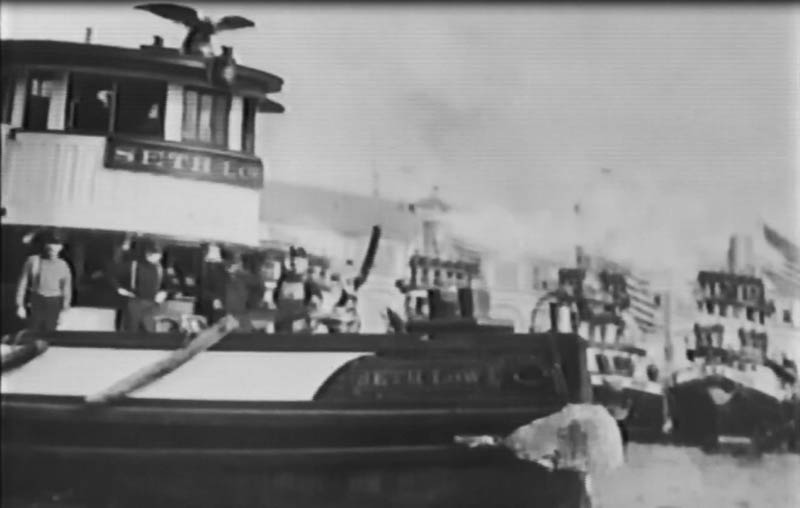
Fireboat
"Seth Low" with fleet John Landers - Beth Klein Collection
"Seth Low"
(1885-1917)
99' x 24' x 9'. 3500 gpm.
Harbeck's Stores, foot of Main Street, Brooklyn
Wooden vessel - copper bottom
Brooklyn Fire Dept
Engine 23

Fireboat
"Seth Low" at the marine shops c.1908-09 John Landers - Beth Klein Collection
"Seth Low"
(1885-1917)
99' x 24' x 9'. 3500 gpm.
Harbeck's Stores, foot of Main Street, Brooklyn
Wooden vessel - copper bottom
Brooklyn Fire Dept
Engine 23
EXTREMELY RARE PHOTO
Showing the Seth Low in Reserve Status c.1908-1909
ARTICLE FROM JAN 30, 1904
"Seth Low"
(1885-1917)
99' x 24' x 9'. 3500 gpm.
Harbeck's Stores, foot of Main Street, Brooklyn
Wooden vessel - copper bottom
Brooklyn Fire Dept
Engine 23





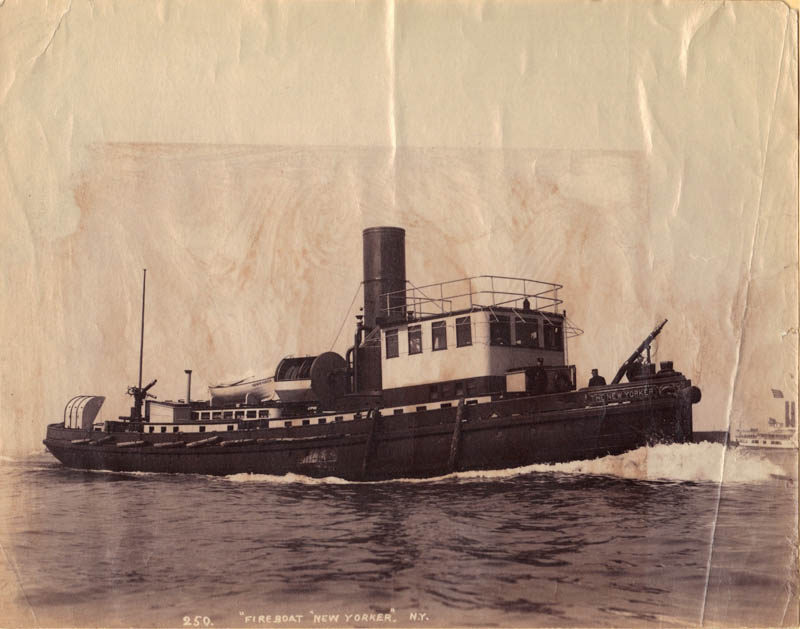
"The New Yorker" an early photo - John Landers - Beth Klein Collection
"The New Yorker"
(1890-1931)
125' x 26' x 12'. 13,000 gpm.
Early photo shown prior to installation of the roof deck monitors
and the name plate being placed
on the pilot house. Also shown with original style stack and square
portholes.
Photos of the New Yorker showing square
portholes date to when the crew lived on board the vessel.

"The
"The New Yorker" John Landers - Beth Klein Collection
"The New Yorker"
(1890-1931)
125' x 26' x 12'. 13,000 gpm.
Steel hull - Coal fired Steam power
Castle Garden, Battery, Manhattan
"Engine 57"

January 1891 Harper's Weekly wood etching of "The New Yorker"
John Landers - Beth Klein Collection
"The New Yorker"
(1890-1931)
125' x 26' x 12'. 13,000 gpm.
Steel hull - Coal fired Steam power
Castle Garden, Battery, Manhattan
"Engine 57"

Fireboat "The New Yorker" at Castle Garden Bulkhead in 1893
John Landers - Beth Klein Collection
"The New Yorker"
(1890-1931)
125' x 26' x 12'. 13,000 gpm.
Steel hull - Coal fired Steam power
Castle Garden, Battery, Manhattan
"Engine 57"

Fireboat "The New Yorker" at quarters in 1899
John Landers - Beth Klein Collection
"The New Yorker"
(1890-1931)
125' x 26' x 12'. 13,000 gpm.
Steel hull - Coal fired Steam power
Castle Garden, Battery, Manhattan
"Engine 57"

"The New Yorker" at the Engine 57 Quarters at the Battery.
Note the black and red color scheme.
John
Landers - Beth Klein Collection
"The New Yorker"
(1890-1931)
125' x 26' x 12'. 13,000 gpm.
Built by Julius Johnson of New York City
Steel hull - Coal fired Steam power
Castle Garden, Battery, Manhattan
"Engine 57"
Note: The New Yorker was the first New York
fireboat with quarters
on shore. Previous boats had accommodations on board for the crew.

"The New Yorker" ready to entertain a massive crowd at the Battery.
John
Landers - Beth Klein Collection
"The New Yorker"
(1890-1931)
125' x 26' x 12'. 13,000 gpm.
Built by Julius Johnson of New York City
Steel hull - Coal fired Steam power
Castle Garden, Battery, Manhattan
"Engine 57"

"The New Yorker" with Chief John Kenlon on deck watching monitor
operations.
John
Landers - Beth Klein Collection
"The New Yorker"
(1890-1931)
125' x 26' x 12'. 13,000 gpm.
Built by Julius Johnson of New York City
Steel hull - Coal fired Steam power
Castle Garden, Battery, Manhattan
"Engine 57"

"The New Yorker" with Pier A in background John
Landers - Beth Klein Collection
"The New Yorker"
(1890-1931)
125' x 26' x 12'. 13,000 gpm.
Built by Julius Johnson of New York City
Steel hull - Coal fired Steam power
Castle Garden, Battery, Manhattan
"Engine 57"
Note: The New Yorker was the first New York
fireboat with quarters
on shore. Previous boats had accommodations on board for the crew.

"The New Yorker" Engine 57 quarters at the Battery John Landers - Beth Klein Collection
"The New Yorker"
(1890-1931)
125' x 26' x 12'. 13,000 gpm
Steel hull - Coal fired Steam power
Castle Garden, Battery, Manhattan
"Engine 57"

Engine 57 original headquarters at the Battery John Landers - Beth Klein Collection
"The New Yorker"
(1890-1931)
125' x 26' x 12'. 13,000 gpm
Steel hull - Coal fired Steam power
Castle Garden, Battery, Manhattan
"Engine 57"

Blessing of the fireboats by Cardinal Loesch at the Battery in 1914
John Landers - Beth Klein Collection
"The New Yorker"
(1890-1931)
125' x 26' x 12'. 13,000 gpm
Steel hull - Coal fired Steam power
Castle Garden, Battery, Manhattan
"Engine 57"

Dignitaries aboard "The New Yorker" for the fireboats blessing 1914.
John Landers - Beth Klein Collection
"The New Yorker"
(1890-1931)
125' x 26' x 12'. 13,000 gpm
Steel hull - Coal fired Steam power
Castle Garden, Battery, Manhattan
"Engine 57"

"The New Yorker" John Landers - Beth Klein Collection
"The New Yorker"
(1890-1931)
125' x 26' x 12'. 13,000 gpm.
Steel hull - Coal fired Steam power
Castle Garden, Battery, Manhattan
"Engine 57"
Shown as Engine 57 quarters (left) at the Battery, Manhattan

"The New Yorker" at the Battery John Landers - Beth Klein Collection
"The New Yorker"
(1890-1931)
125' x 26' x 12'. 13,000 gpm.
Steel hull - Coal fired Steam power
Castle Garden, Battery, Manhattan
"Engine 57"
Shown as Engine 57 quarters (left) at the Battery, Manhattan

"The New Yorker" at Pier A showing original design
with deckgun flowing.
John Landers - Beth Klein Collection
"The New Yorker"
(1890-1931)
125' x 26' x 12'. 13,000 gpm.
Steel hull - Coal fired Steam power
Castle Garden, Battery, Manhattan
"Engine 57"

"The New Yorker" at the launching of the Thomas Willet at Newburgh,
NY 1908.
John Landers - Beth Klein Collection
"The New Yorker"
(1890-1931)
125' x 26' x 12'. 13,000 gpm.
Steel hull - Coal fired Steam power
Castle Garden, Battery, Manhattan
"Engine 57"

"The New Yorker" operating at a fire John Landers - Beth Klein Collection
"The New Yorker"
(1890-1931)
125' x 26' x 12'. 13,000 gpm.
Steel hull - Coal fired Steam power
Castle Garden, Battery, Manhattan
"Engine 57"

"The New Yorker" and the launch "Velox" John Landers - Beth Klein Collection
"The New Yorker"
(1890-1931)
125' x 26' x 12'. 13,000 gpm
Steel hull - Coal fired Steam power
Castle Garden, Battery, Manhattan
"Engine 57"
.
"The New Yorker" and crew on the bow - John Landers - Beth Klein Collection
"The New Yorker"
(1890-1931)
125' x 26' x 12'. 13,000 gpm
Steel hull - Coal fired Steam power
Castle Garden, Battery, Manhattan
"Engine 57"

"The New Yorker" and "Zophar Mills" fight fire in
German Freighter
John Landers - Beth Klein Collection
"The New Yorker"
(1890-1931)
125' x 26' x 12'. 13,000 gpm
Steel hull - Coal fired Steam power
Castle Garden, Battery, Manhattan
"Engine 57"

"The New Yorker" battling the City of Stamford ferryboat fire
John Landers - Beth Klein Collection
"The New Yorker"
(1890-1931)
125' x 26' x 12'. 13,000 gpm
Steel hull - Coal fired Steam power
Castle Garden, Battery, Manhattan
"Engine 57"

"The New Yorker" tackles the German ocean liner Hamburg blaze
John Landers - Beth Klein Collection
"The New Yorker"
(1890-1931)
125' x 26' x 12'. 13,000 gpm
Steel hull - Coal fired Steam power
Castle Garden, Battery, Manhattan
"Engine 57"

"The New Yorker" water display.
John Landers - Beth Klein Collection
"The New Yorker"
(1890-1931)
125' x 26' x 12'. 13,000 gpm
Steel hull - Coal fired Steam power
Castle Garden, Battery, Manhattan
"Engine 57"

"The New Yorker" is escorted by the "John Purroy Mitchel" and the
"Thomas Willet"
on her last trip
around New York Harbor in 1931.
John Landers - Beth Klein Collection
"The New Yorker"
(1890-1931)
125' x 26' x 12'. 13,000 gpm
Steel hull - Coal fired Steam power
Castle Garden, Battery, Manhattan
"Engine 57"

"The New Yorker" in dry dock.
John Landers - Beth Klein Collection
"The New Yorker"
(1890-1931)
125' x 26' x 12'. 13,000 gpm
Steel hull - Coal fired Steam power
Castle Garden, Battery, Manhattan
"Engine 57"

A colorized image of "The New Yorker" at Engine 57 c.1937
Submitted by John Landers and Beth Klein
"The New Yorker"
(1890-1931)
125' x 26' x 12'. 13,000 gpm
Steel hull - Coal fired Steam power
Castle Garden, Battery, Manhattan
"Engine 57"

Brooklyn Fireboat "David A. Boody"
John Landers - Beth Klein Collection
David A. Boody
(1892-1914)
105' x 23' x 7'. 6500 gpm.
Built by W. Cowles at Noank, Connecticut
Wooden hull - coal and steam powered
Brooklyn Fire Dept
Engine 32

Brooklyn Fireboat "David A. Boody" - John Landers - Beth Klein Collection
David A. Boody
(1892-1914)
105' x 23' x 7'. 6500 gpm.
Built by W. Cowles at Noank, Connecticut
Wooden hull - coal and steam powered
Brooklyn Fire Dept
Engine 32

Brooklyn Fireboat "David A. Boody" -
John Landers - Beth Klein Collection
David A. Boody
(1892-1914)
105' x 23' x 7'. 6500 gpm.
Built by W. Cowles at Nohank, Connecticut
Wooden hull - coal and steam powered
Brooklyn Fire Dept
Engine 32
|
Clipping from New York Times -
February 14, 1899
 |
David A. Boody
(1892-1914)
105' x 23' x 7'. 6500 gpm.
Brooklyn Fire Dept
Engine 32

Former
Brooklyn Fireboat "David A. Boody" after her FDNY usage
John Landers - Beth Klein Collection
David A. Boody
(1892-1914)
105' x 23' x 7'. 6500 gpm.
Brooklyn Fire Dept
Engine 32
|
The DAVID A. BOODY
A clipping from Brooklyn Daily Eagle, August 15, 1930
Provided by John Landers & Beth Klein
ONCE LAST WORD IN
FIREBOATS
Before Brooklyn
became a borough the David A. Boody was built by
its Mayor of that time to be the last word in fireboats.
She is shown as she looks nowadays, as a steam lighter
along the Brooklyn waterfront.
Proud of the
fact that their ship is the sole survivor of the days
when the City of Brooklyn operated its own fireboats,
sailors on the steam lighter David A Boody are
honoring the name of the last Democratic Mayor in
Brooklyn who named her after himself 38 years ago.
According to
the Boody's Chief Engineer Robert Champeau, they are
planning to collect a quarter each time one of her crew
lets loose with an oath (curse). Problem is the crew is
simply not profane enough. The fund will be used for
purchasing and installing in the pilot house a deluxe
size photo properly framed of the late Mr. Boody.
The steam
lighter was tied up undergoing two day of repairs after
delivering a load of rank-smelling hides to the Butler
Warehouses. The fact that the flag on the stern of the
Boody was at half mast is what caught this
reporters attention at first. Mr. Champeau said this was
a tribute to Mr. Boody who died five months ago at the
ripe old age of 92. "When we get our picture
we can let the flag run all the way up."
"She is one
powerful vessel" said the Chief Engineer who has been
with her since she was condemned for firefighting in the
harbor 13 years ago. "Actually, she was too powerful"
according to Champeau. "When she turned the full force
of her pumps on her top seams would open. Mayor Boody
had her built that way. In her day she was the fastest
fireboat in the harbor, and for speed of delivering
water I don't think they could beat her today. She is a
big little boat, even now she can carry up to 150 tons
of freight at 12 mph. I don't think another steam
lighter in the harbor, with the exception of the Jack
Frost can pass her when she is stepping."
"I know
her from stem to stern. I took her fireboat engine and
pumps out in 1917. Her present engine is as much of a
veteran as herself. It came from the Croton which
was a former water boat. The Boody's bottom is as
clean as her pilot house window pane and she has one of
the finest shaped hulls in port. Between her deckhouse
and her forward cleat she can carry 730 drums of asphalt
standing on end" added Champeau who proudly boasted the
little known fact that the Boody has served both
the City of Brooklyn and her country as the Navy took
her over during the war and kept her five years, longer
than any other boat. "In those days she was housed in,
carrying fruits and other stuff from the Navy Yard to
ships in the harbor. She's done her job and done it well
for many years and we are glad she's ours cause she has
many more years of harbor service left in her.
|
|
|
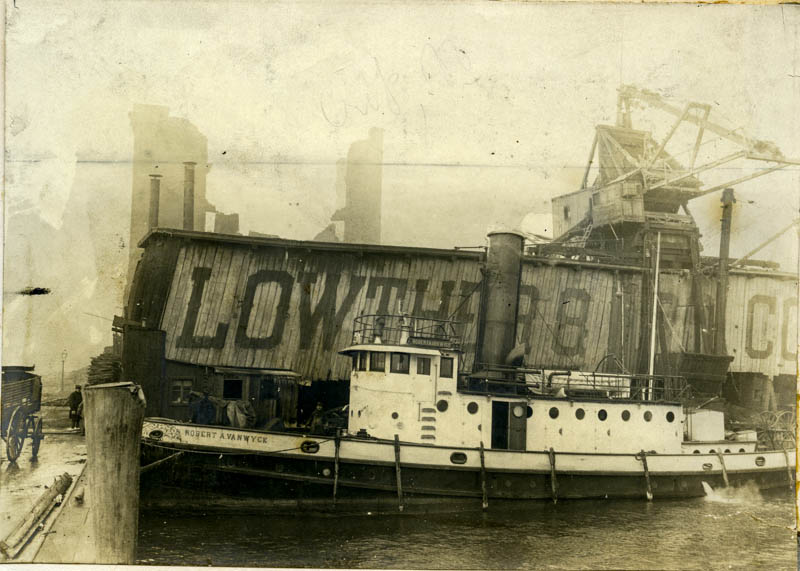
Fireboat "Robert A. Van Wyck" John Landers - Beth Klein
Collection
"Robert A. Van Wyck*"
(1898-1948)
110' x 24' x 12.6'. 6500 gpm
Designed by H deB Parsons
Built by J. H. Dialogue & Son
Steel hull,
203 gross tons, 10 knots
Coal Fired
Berth Foot of Grand Street, Manhattan
"Engine 66"
*This boat was originally christened as the "William L Strong" but the name was
changed to the
"Robert A. Van Wyck" prior to going into service (Van Wyck was the Mayor at the
time).
It was renamed the "William L Strong" once again after the mayor's term ended..

Fireboat "William L Strong" taking up hose in snow - John Landers - Beth Klein
Collection
"William L. Strong"
(1898-1948)
100' x 24' x 12.6'. 6500 gpm.
(AKA the Robert A VanWyck)
Designed by H deB Parsons
Built by J. H. Dialogue & Son
Steel hull,
203 gross tons, 10 knots
Coal Fired
Berth Foot of Grand Street, Manhattan
"Engine 66"
Extremely Rare picture showing the "Strong" with an extended crew cabin from her
early days
(see the Van Wyck above). The extended cabin was removed within 6 months of her
being
renamed as the "William L Strong" again.
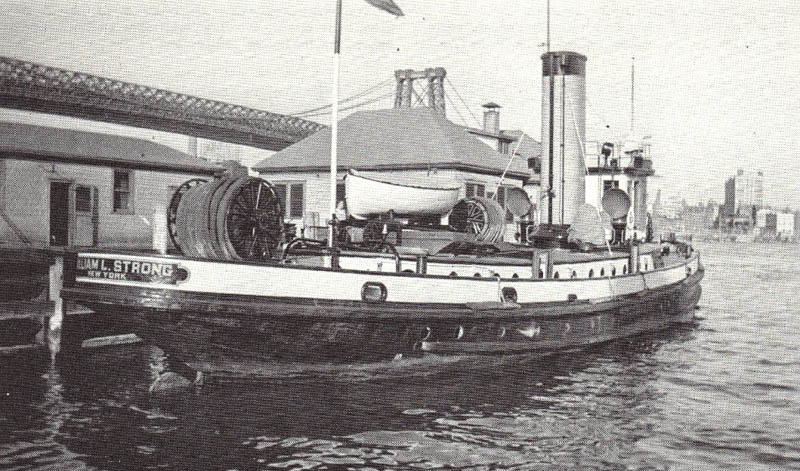
Fireboat "William L Strong" John Landers - Beth Klein
Collection
"William L. Strong"
(1898-1948)
100' x 24' x 12.6'. 6500 gpm.
Designed by H deB Parsons
Built by J. H. Dialogue & Son
Steel hull,
203 gross tons, 10 knots
Coal Fired
Berth Foot of Grand Street, Manhattan
"Engine 66"

Fireboat "William L Strong" & Tender "Smoke" John Landers - Beth Klein
Collection
"William L. Strong"
(1898-1948)
100' x 24' x 12.6'. 6500 gpm.
Designed by H deB Parsons
Built by J. H. Dialogue & Son
Steel hull,
203 gross tons, 10 knots
Coal Fired
Berth Foot of Grand Street, Manhattan
"Engine 66"

Fireboat "William L Strong" salutes USA military fleet 1936
John Landers - Beth Klein
Collection
"William L. Strong"
(1898-1948)
100' x 24' x 12.6'. 6500 gpm.
Designed by H deB Parsons
Built by J. H. Dialogue & Son
Steel hull,
203 gross tons, 10 knots
Coal Fired
Berth Foot of Grand Street, Manhattan
"Engine 66"

Fireboat "William L Strong" water display John Landers - Beth Klein
Collection
"William L. Strong"
(1898-1948)
100' x 24' x 12.6'. 6500 gpm.
Designed by H deB Parsons
Built by J. H. Dialogue & Son
Steel hull,
203 gross tons, 10 knots
Coal Fired
Berth Foot of Grand Street, Manhattan
"Engine 66"

Fireboats "New Yorker" and "William L Strong" operating
John Landers - Beth Klein
Collection
"William L. Strong"
(1898-1948)
100' x 24' x 12.6'. 6500 gpm.
Designed by H deB Parsons
Built by J. H. Dialogue & Son
Steel hull,
203 gross tons, 10 knots
Coal Fired
Berth Foot of Grand Street, Manhattan
"Engine 66"

Fireboat "William L. Strong" and crew circa 1936.
John Landers - Beth Klein
Collection
"William L. Strong"
(1898-1948)
100' x 24' x 12.6'. 6500 gpm.
Designed by H deB Parsons
Built by J. H. Dialogue & Son
Steel hull,
203 gross tons, 10 knots
Coal Fired
Berth Foot of Grand Street, Manhattan
"Engine 66"

Fireboats "William L. Strong" and "John Purroy Mitchel"
battling a waterfront warehouse fire in March 1936.
NOTE: This is one of the earliest known color photos of the FDNY.
John Landers - Beth Klein
Collection
"William L. Strong"
(1898-1948)
100' x 24' x 12.6'. 6500 gpm.
Designed by H deB Parsons
Built by J. H. Dialogue & Son
Steel hull,
203 gross tons, 10 knots
Coal Fired
Berth Foot of Grand Street, Manhattan
"Engine 66"
______________________________
GO TO NEXT PAGE 13
For fireboats 1900 - 1950
______________________________
GO TO NEXT PAGE 14
For fireboats 1951 - 2000
______________________________
-------------------------
Thanks to John Landers and Beth Klein for sharing these amazing
historical images
of these old FDNY fireboats
August 2013 - September 7, 2015 |


![]() Photos by Britton W Crosby
Photos by Britton W Crosby
![]()


![]()

![]()


![]()
![]() FIREBOATS
FIREBOATS![]() FROM
FROM
![]()